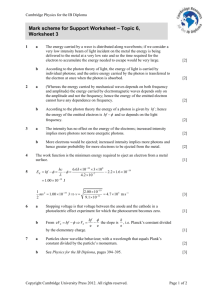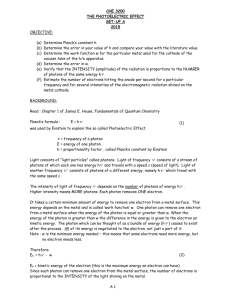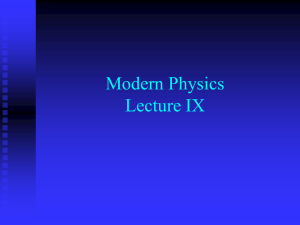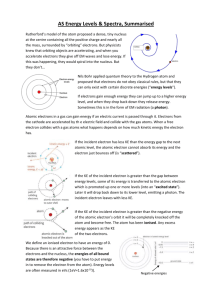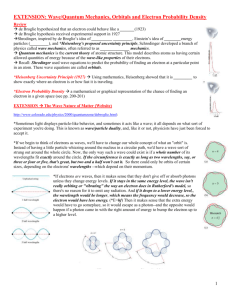12 PHYSICS TERM 4 ATOMIC AND NUCLEAR PHYSICS REVISION
advertisement
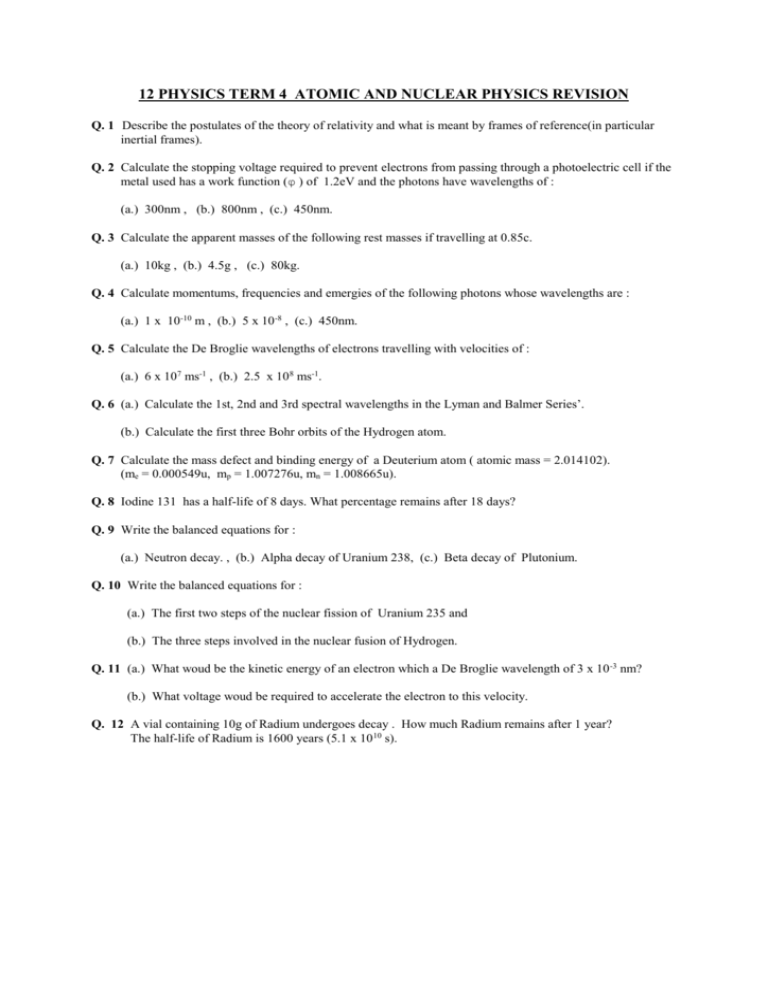
12 PHYSICS TERM 4 ATOMIC AND NUCLEAR PHYSICS REVISION Q. 1 Describe the postulates of the theory of relativity and what is meant by frames of reference(in particular inertial frames). Q. 2 Calculate the stopping voltage required to prevent electrons from passing through a photoelectric cell if the metal used has a work function (φ ) of 1.2eV and the photons have wavelengths of : (a.) 300nm , (b.) 800nm , (c.) 450nm. Q. 3 Calculate the apparent masses of the following rest masses if travelling at 0.85c. (a.) 10kg , (b.) 4.5g , (c.) 80kg. Q. 4 Calculate momentums, frequencies and emergies of the following photons whose wavelengths are : (a.) 1 x 10-10 m , (b.) 5 x 10-8 , (c.) 450nm. Q. 5 Calculate the De Broglie wavelengths of electrons travelling with velocities of : (a.) 6 x 107 ms-1 , (b.) 2.5 x 108 ms-1. Q. 6 (a.) Calculate the 1st, 2nd and 3rd spectral wavelengths in the Lyman and Balmer Series’. (b.) Calculate the first three Bohr orbits of the Hydrogen atom. Q. 7 Calculate the mass defect and binding energy of a Deuterium atom ( atomic mass = 2.014102). (me = 0.000549u, mp = 1.007276u, mn = 1.008665u). Q. 8 Iodine 131 has a half-life of 8 days. What percentage remains after 18 days? Q. 9 Write the balanced equations for : (a.) Neutron decay. , (b.) Alpha decay of Uranium 238, (c.) Beta decay of Plutonium. Q. 10 Write the balanced equations for : (a.) The first two steps of the nuclear fission of Uranium 235 and (b.) The three steps involved in the nuclear fusion of Hydrogen. Q. 11 (a.) What woud be the kinetic energy of an electron which a De Broglie wavelength of 3 x 10 -3 nm? (b.) What voltage woud be required to accelerate the electron to this velocity. Q. 12 A vial containing 10g of Radium undergoes decay . How much Radium remains after 1 year? The half-life of Radium is 1600 years (5.1 x 1010 s). YEAR 12 PHYSICS TERM 4 CRP REVISION.(***SP) Q. 1 (a.) What velocity would an electron have if it was accelerated between two plates with a voltage of 24000V? (b.) What is the De Broglie wavelength of this electron? Q. 2 A 8 tonne elephant charges through the middle of village fair at a speed of 8ms-1. (a.) What is its De Broglie wavelength? (b.) If this elephant was a photon what would be its energy in MeV? ***Q. 3 Do questions 13 and 14 on page 592. ***Q. 4 Do question 25 on page 629. Q. 5 (a.) Calculate the energy required to excite a ground state Hydrogen atom to the 1st,2nd ,3rd and 4th excited states. (b.) What are the possible energies of the electrons passing through the gas and photons being emitted from the gas, if electrons are fired at the gas with the following energies : (i.) 9.0 eV (ii.) 10.2 eV (iii.) 11.2 eV (iv.) 12.1 eV (v.) 13.1 eV (c.) Repeat part(b.) if incident photons are used instead of electrons (only work out energies of emitted photons) Q. 6 If 8% of a radioactive material decays in 9 days, (a.) what is the substance’s half life and (b.) what % is left after 18 days? Q. 7 The wavelength of an emitted photon from excited Hydrogen is 93nm. Assuming that the photon is a result of an electron returning to the ground state, calculate from which energy level the electron fell from. Q. 8 The energy of a photon released as a result of an electron falling from a higher energy level to E3, is measured at 1.97 10-19 J. What was the energy level that the electron fell from? Q. 9 The binding energy of Deuterium is 6.82 MeV. Calculate the mass of the nucleus in a.m.u. to 5 decimal places given that : p = 1.007276u, n= 1.008665u.
